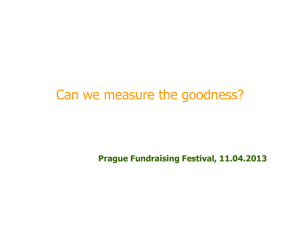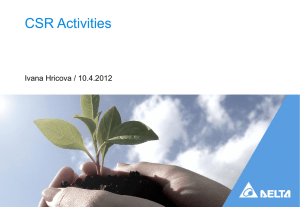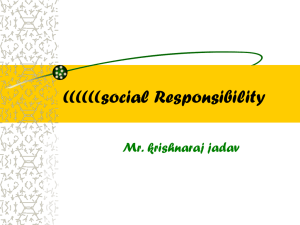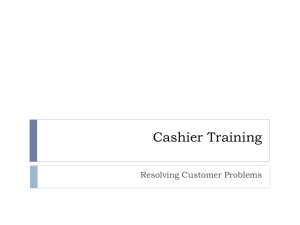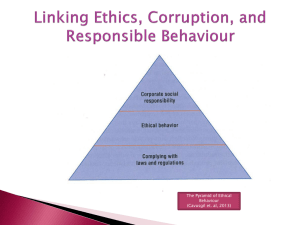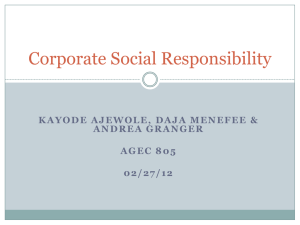Corporate Social Responsibility and Marketing: An Integrative
advertisement
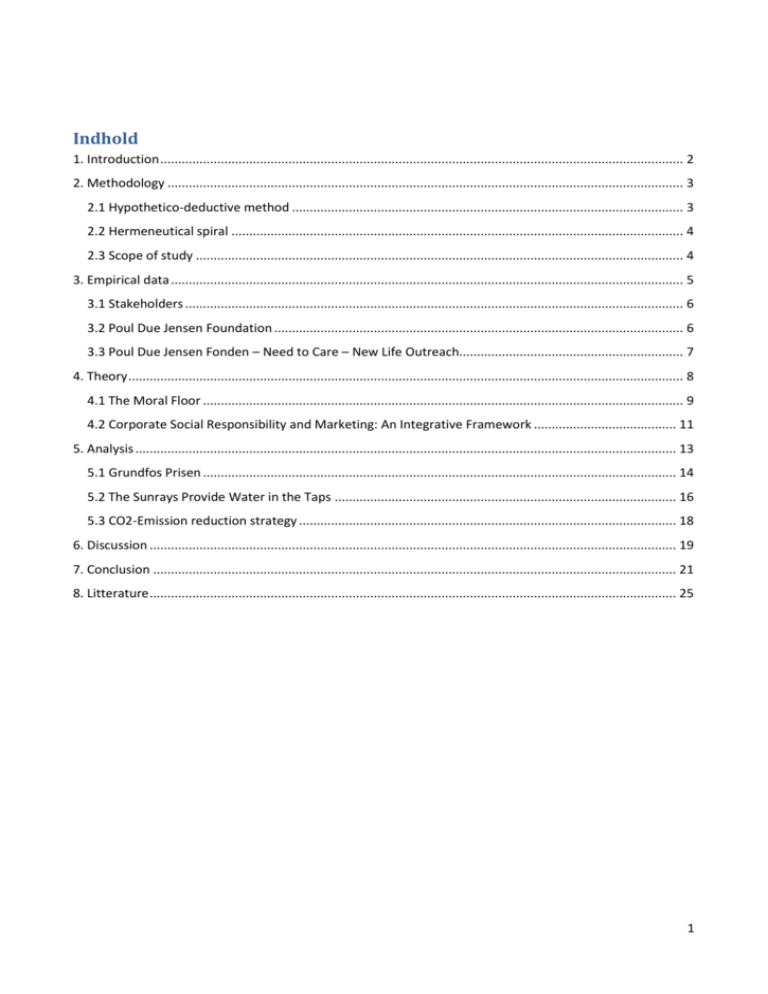
Indhold 1. Introduction ................................................................................................................................................... 2 2. Methodology ................................................................................................................................................. 3 2.1 Hypothetico-deductive method .............................................................................................................. 3 2.2 Hermeneutical spiral ............................................................................................................................... 4 2.3 Scope of study ......................................................................................................................................... 4 3. Empirical data ................................................................................................................................................ 5 3.1 Stakeholders ............................................................................................................................................ 6 3.2 Poul Due Jensen Foundation ................................................................................................................... 6 3.3 Poul Due Jensen Fonden – Need to Care – New Life Outreach............................................................... 7 4. Theory ............................................................................................................................................................ 8 4.1 The Moral Floor ....................................................................................................................................... 9 4.2 Corporate Social Responsibility and Marketing: An Integrative Framework ........................................ 11 5. Analysis ........................................................................................................................................................ 13 5.1 Grundfos Prisen ..................................................................................................................................... 14 5.2 The Sunrays Provide Water in the Taps ................................................................................................ 16 5.3 CO2-Emission reduction strategy .......................................................................................................... 18 6. Discussion .................................................................................................................................................... 19 7. Conclusion ................................................................................................................................................... 21 8. Litterature .................................................................................................................................................... 25 1 1. Introduction The inspiration of this thesis comes from viewing the corporate socially responsible profile of organizations and what initiatives an organization can get involved in to be ethical in their behavior. Many organizations choose to involve in corporate social responsibility (CSR), in many different shapes and sizes – almost all of which appear to have a certain ethical or even philanthropic background. While most CSR initiatives are designed to benefit others outside the organization, whether its society, consumers, the environment or something completely different, it also appears that there is more to engaging in CSR than just benefitting others. Since organizations are so eager to invest in and create initiatives to benefit others, it could appear that there are some positive effects on the organizations themselves. As most organizations seek to find different ways of gaining advantages over one another, it is interesting to see if there is a connection between the ethical standard and moral behavior of an organization and the organizational benefit from this. To investigate this subject, I have chosen to look at the Danish organization Grundfos and their CSR practices as empirical data, as the organization is very distinct in developing their CSR practices, along with the fact that they have many different and widespread initiatives. To do so I have taken Grundfos’ own material online to have an unbiased source and to be able to extract the information that the organization wishes to publish. The general CSR practices of the organization involving a strict environmental profile and other initiatives that are adapted internally in the organization will be analyzed. These practices along with joint ventures done with NGOs provide the empirical core of the thesis. The theoretical data will be two different angles considering how CSR can be initiated and what purposes it serves besides the practical purposes, and why organizations choose to engage in CSR in general. Explaining this may give an indication of why Grundfos has chosen to actively invest in CSR, and why the organization has chosen so many different CSR initiatives. The other theory will be emphasizing the moral aspect of CSR and suggest whether or not it is possible for organizations to benefit from their CSR, and how this can be done. Using the theories I will try to explain and investigate the connection between ethical behavior in Grundfos and the benefit the organization can draw from this ethical behavior, if any. 2 This leads to the problem statement: “To which degree is it possible for Grundfos to benefit from its own corporate socially responsible behavior when this behavior is a way of helping others?” To answer this statement I will include sources from Grundfos and the two different theoretical approaches. 2. Methodology In terms of methodology, I have used the hypothetical deductive method and hermeneutical spiral as they both rely on pre-understanding for analytical purposes. Both represent a certain level of evaluation during the process of analyzing, which has been relevant for my result in defining how and if Grundfos can benefit from their CSR practices. These are also relevant methods when viewing articles of the like that will be evaluated in this thesis, as they represent a certain source and are therefore likely to represent a certain standpoint as well. For instance sources published by the organization itself can be assumed to have a certain level promotional value for the organization, which can then help to determine the pre-understanding that is relevant to the thesis. 2.1 Hypothetico-deductive method The Hypothetico-deductive method (Readings in the Philosophical Social Science, Michael Martin & Lee Mcintyre, Massachusetts Institute of Technology, 1994, pp.232-234) is a method often used in analyzing literature or meaningful material. This method seeks to make a series of hypotheses based on the material that is analyzed and the connection with our beliefs. Essentially the method seeks to falsify these hypotheses, as there is no “ultimate” or complete hypothesis – but there are hypotheses that are falsified and from that falsification, a new hypothesis can be made from the knowledge of the falsified one. This method is a process of understanding and interpreting material – and proceeding to widen the understanding of the general thought behind the hypothesis, that is then ultimately cast away and leads to a new one. This method has been used to falsify thoughts and hypotheses about the relationship between CSR and organizational performance for instance, to ultimately make the most thought through hypothesis. 3 2.2 Hermeneutical spiral The hermeneutical spiral (Humanistisk videnskabsteori, Finn Collin & Simon Køppe, DR multimedia 2003, pp.146-147) is a method used by introducing and idea or a pre-understanding of a text or subject, and then seek to extend that knowledge throughout the process of analyzing. In this particular thesis, the method of the hermeneutical spiral was used as I had a pre-understanding of the subject of CSR and an expectation about certain relationships between CSR and organizational success which ultimately lead me to a problem statement. When looking at the sources from Grundfos, there is a clear pre-assumption that the articles depicted in this thesis serve a certain purpose. With the hermeneutical spiral, understanding the relationship of the parts and the whole, is essential to analyzing and understanding the process of creating the thesis based on ones understanding of the whole (Collin & Køppe, pp.146-147). Understanding the whole being for instance the idea of how CSR can benefit an organization like Grundfos, as it is presumed in this thesis, is the pre-understanding – a pre-understanding of the “whole” that is before the parts have been looked further into. The parts and the whole have an entwined relationship, where the understanding of both shifts as one moves further into the process of reading the articles and understanding the subject further. Ultimately a theory or hypothesis is assumed and will be the base of this bachelor-thesis. 2.3 Scope of study An angle that could have been relevant when looking into the creation of CSR and how Grundfos implements CSR is to look at and analyze the discourse the organization has chosen. A discourse analysis (Collin & Køppe, pp. 292) which essentially regards the chosen discourse within an organization, and how the organization will try and implement that discourse in their CSR marketing for instance. Another perspective could have been to look at social-constructivism (Collin & Køppe, pp.248) and how this has affected the idea of CSR in general. This would perhaps have become an even more philosophical view of the corporate CSR initiatives. Social-Constructivism regards how expectations in any relation is formed through repetition in society, that ultimately creates norms, 4 which could have been relevant as it might have given an estimate of how and why CSR is even an issue and where the demand comes from. These methods could have been interesting but would have given a different perspective on the thesis as a whole. To investigate the whole aspect of to which degree organizations can benefit from implementing CSR in their organization, it could also prove to be relevant to look at economic theory and consumer behavior; however these aspects are left out as the emphasis of the thesis has to do with the moral aspect of CSR and the connection with business performance. 3. Empirical data As empirical data regarding CSR practices, I have chosen to look at the Danish organization Grundfos and some of the CSR initiatives that define their corporate profile, and how the organization communicates these initiatives. The initiatives that characterize Grundfos include more stereotypical CSR initiatives such as goals to reduce CO2 emissions and general business ethics, but also include less traditional CSR initiatives. The reason for choosing Grundfos is primarily the widespread CSR initiatives that define the organization – while some organizations will target their CSR into one or a few specific areas Grundfos has chosen to target many different aspects within the field of CSR. Rather than looking at one specific case as empirical data, it can prove to be more relevant to look at the many different initiatives that define the organizations CSR policy, while this will provide a more general and nuanced view of how CSR can benefit the organization. In terms of the process of analyzing the material, this will most likely provide an even broader and more solid empirical backing to ultimately define how their CSR practices add advantages to the company and how they manage to benefit from these advantages, if they manage to do so. As the source of the empirical data I have chosen the data available through articles and sources published by the organization itself, while still being factual, this particular type of source is more likely to represent the specific details the organization wishes to publish. Additionally there are 5 sources from the organizations foundation that is connected with the organization – these will also most likely be representing a certain level of promotion of the organization and its values. Looking at the number of different CSR initiatives and the variety of these, there are indications that Grundfos is pursuing a wider CSR strategy that emphasizes not only that which benefits key stakeholders, but also smaller and less obvious cases. This is part of reason why the organizations corporate social behavior is relevant to look at, while most organizations practice CSR to a certain extent, Grundfos appears to have a great emphasis on CSR. The size of the organization is worth mentioning as it is always easier to increase CSR initiatives as a larger organization, but this great CSR strategy could also prove to be a link in Grundfos’ strategy in general, something which will be investigated in the analysis. 3.1 Stakeholders The reason stakeholders (Strategic CSR communication, Morsing & Beckmann, Djøf Publishing, 2013, p.138) are relevant to mention when focusing on CSR in an organization is that organizations are often influenced by stakeholders. Stakeholders can influence anything from products to CSR practices in an organization, often by basic demand principles – this goes for both internal and external stakeholders. In other words, stakeholders are relevant to any organization today, and can influence most aspects of almost any organization as well. Therefore in terms of organizational CSR practices, stakeholders are important in defining what is most relevant for the organization and how to actively engage in CSR. In any organization there are numerous stakeholders internally (employees, managers, directors etc.) and externally (Society, consumers, NGO’s etc.) that are all pulling in different directions in terms of which CSR initiatives are relevant to look at. Most organizations will perhaps seek to satisfy their primary stakeholders by satisfying their demand for CSR before stakeholders that are less relevant to the organization. 3.2 Poul Due Jensen Foundation Having mentioned stakeholders previously, one key stakeholder to Grundfos as well as other innovative businesses is innovative workforce. Innovative workforce or innovative workers can perhaps be acquired through recruitment and other processes, but getting a foot in the door with scientific researchers and organizations that comply with the same standard that Grundfos has for 6 their products has been done while obtaining a certain degree of CSR in the organization. While benefitting from the research, Grundfos has also managed to support sustainability. Poul Due Jensen Fonden (a foundation named after the founder of Grundfos) has an annual award called “Grundfosprisen” (Web: Poul Due Jensen Fonden, The Sunrays Provide Water in the Taps), a 1 Million DKK award is awarded to scientific researchers whose studies are innovative and sustainable in the fields of natural science and/or technical science. The award is therefore awarded to research within the industry, benefitting the industry, but is chosen from the premises given by Poul Due Jensen Fonden. The award is 250.000 DKK given to the winner or winning organization, and 750.000 DKK donated towards further development of the winning idea or project. The award is interesting in regards to the investigation of CSR strategies, as it differs from more traditional strategies, as it supports ethical initiatives indirectly. Keeping in mind that this is an addition to other CSR initiatives by the organization, this helps them fathom more than just one or few elements of the CSR genre. 3.3 Poul Due Jensen Fonden – Need to Care – New Life Outreach While the Prize is one of the initiatives that clearly benefit the organization and the industry, there are other cases which are a bit more beyond the geographical jurisdiction of Grundfos in terms of CSR, something of a bit more philanthropic character. In Olosiva, Tanzania, Grundfos supports a project of sustainability (http://www.poulduejensensfond.dk/#/page1118/story1615) that helps the local population retain water from solar-powered pumping stations. These stations are mounted with Grundfos Pumps “SQFlex” and provides 5.000 liters/hour, something that determines their quality of products meanwhile they are emphasizing the good deed. The initiative is made in cooperation with a Danish NGOs “Need To Care” and “New Life Outreach” that do philanthropic work around the globe – their work is done “By showing benevolence by supporting those in need” (Web: Need to Care, 2012). The organizations involved in this project are providing sustainability, similar to the; 7 “Give a man a fish and feed him for a day, teach a man to fish and feed him for a lifetime”principle. (Anne Isabella Thackeray Ritchie, Mrs. Dymond, 1885) While providing clean drinking water – and making sure that this project will provide for the local community many years to come, it also goes to show that Grundfos implements their products and their own organization in the CSR initiatives that are supported by the organization or by the foundation. A few of the initiatives by Poul Due Jensen Fonden will appear in the analysis to give a full view of the Foundations work. 4. Theory As theory I have chosen two different theories that regards to different sides of the empirical data; the essence of CSR that is the good deed and what purpose is behind taking action towards becoming a more responsible organization, and the essence regarding the purpose for marketing and how the organization can benefit from doing CSR in their initiatives. For the CSR angle I have chosen a theory called “The Moral Floor” that emphasizes the idea that CSR will benefit the organization to a certain degree, and from then on CSR initiatives are less beneficial for the organization as their actions can be considered either over the top or simply too far from the relevance of the company. To enlighten the other angle that emphasizes the design behind the CSR initiatives, and how it is generally constructed and what purpose it could serve, I have chosen to look at (Corporate Social Responsibility and Marketing: An Integrative Framework, Maignan & Ferrell, Journal of the academy of marketing science, 2004). This article is focusing on the underlying reasons for using CSR in general, but also what role CSR plays for organizations in their marketing. Generally it emphasizes the perspective that is how organizations pick from a variety of different CSR initiatives and how they use it to strengthen the organization in marketing. 8 4.1 The Moral Floor (Brian K. Burton, Michael G. Goldsby, Journal of business ethics, 91 (2009) pp.145-154) The Moral Floor breaking with the traditional “good ethics is good business” (pp.146) idea, that has more or less determined that good ethical corporate behavior will be acknowledged and therefore become good business. There are given examples of how “Good ethics is good business” and “bad ethics is bad business” (pp.146), principles that have occurred due to the: “Underlying assumption that actors in the economical marketplace respond to the moral aspect of business behavior”(pp.146) While this statement has proven to be true many times before, it appears there is a tendency to apply this principle to all of the ethical behavior of businesses; it may prove to be not quite as applicable as previously believed. On a number of different aspects, good ethical behavior will have a positive influence on the organization, Burton and Goldsby argue that (pp.147): If employees are treated well, their productivity will rise If suppliers are treated well, they will respond with favorable prices and long-term contracts If customers are treated well, they will be more loyal than otherwise If investors and creditors are treated well, they will buy more stock or give increased access to funding and relatively low interest rates If government (to use a general term) is treated well, it will respond with favorable decisions regarding regulation The opposites of these statements (all of the above treated poorly) should in theory result in the opposite reaction. While it is supported by traditional economic theory (pp.147) that good ethical behavior is rewarded, it is uncertain to which degree moral obligatory behavior is rewarded and to which degree anything further than moral obligatory behavior is rewarded. 9 What the theory suggests is not only that it is difficult to measure how businesses are rewarded by good ethical behavior, but also the fact that ethical behavior in general is something that is open to interpretation, and that this evaluation has an effect on what can be perceived as ethical behavior (pp.151). Therefore it is extremely difficult to determine whether an organization actually benefits from their CSR practices financially, and which of their CSR initiatives are merely considered “morally obligatory” and therefore expected by society. In the theory it is then suggested that the existence of a “moral floor” is likely, while behavior that is ethical and socially responsible most often can be considered somewhat expected by society and norms, and unethical behavior is less usual by businesses, and unethical behavior is also determined by what is beneath the moral floor. Burton and Goldsby proceed to claim that there is a rather great likelihood that actors in a marketplace will not reward actions that are above the “moral floor” (pp.153) but rather punish behavior that can be considered unethical (anything that is beneath the moral floor they suggest). (Brian K. Burton, Michael G. Goldsby, Journal of business ethics, 91 (2009) pp.146) 10 The model above shows how the ethical behavior, according to the theory, can reach a level where it is no longer profitable or financially rewarded to invest in. The general idea in behind this theory is that: “We must remember the types of moral judgment as we think of acts that in popular terminology would be “ethical” or “unethical”. ”Good ethics” is an external measure, a judgment made by (in this case) the general public. However an act characterized by the general public as “ethical” could be morally obligatory, morally permissible, or morally supererogatory.” (pp.151) This indicates that there is a certain level of interpretation in terms of to which “ethical level” an ethical act belongs. This supports their argument that in most cases bad ethical behavior will be punished rather than good ethical behavior will be rewarded. Finally they conclude their theory by stating that: “We can wish that all businesses acting morally are rewarded financially. We also can wish that all businesses acting immorally are punished financially. But the reality is far more complicated than that. (…) But there is some possibility that a moral floor exists for actors in the economic marketplace – that they demand a certain level of moral behavior from managers and accept behavior at higher moral levels without necessarily rewarding managers who so act”. (pp.152) This theory is then indicating that there is a certain connection between ethical behavior and business results, but only to a certain degree. 4.2 Corporate Social Responsibility and Marketing: An Integrative Framework To add more angles to the theoretical perspective of CSR practices, I have chosen to use another scientific research journal, that emphasizes the idea of how CSR occurs, and what motivates the organizations to invest in CSR. “This article introduces a conceptualization of corporate social responsibility (CSR) that emphasizes the role and potential contribution of the marketing discipline” (Corporate Social Responsibility and Marketing: An Integrative Framework, Maignan & Ferrell, Journal of the academy of marketing science, 2004) 11 As stated above, this article emphasizes the potential contribution of CSR in a marketing perspective, or in other words; if or how CSR initiatives can benefit an organization in their marketing. In this thesis, this theory would then act as an addition to “The moral floor” theoretical perspective by adding the aspect of corporate marketing, and then depicting whether or not organizations can benefit from their CSR initiatives, and if they can – how they manage to do so. The reason for choosing this particular article as theory is its practical emphasis and the possibility that it could enlighten the analysis from a different angle and result in a more thorough analytical perspective on CSR as a whole. This article is more of an advanced stakeholder approach that emphasizes the role of the stakeholder and how organizations interact with stakeholders through their CSR and ultimately how this could benefit the organization. The article suggests that CSR occur by meeting stakeholders understanding of norms defined by organizations and stakeholders, which could indicate that CSR in many cases is a way of reaching out to stakeholders and meeting their demands, rather than an excessive marketing strategy by the organization itself: “Organizations act in socially responsible manner when they align their behaviors with the norms and demands embraced by their main stakeholders” (pp.4) This indicates that stakeholders are essential to the CSR practices of organizations, but also that responsible behavior is defined by meeting the demands of stakeholders – especially the primary stakeholders. Once again, it also defines CSR as a way of meeting a social standard rather than exceeding the expectations given from a certain group (or groups) of stakeholders. Furthermore the authors suggest that choosing a CSR path is a product of stakeholder opinion, but not necessarily limited to the stakeholders own benefit. Therefore the research indicates that there is a possibility that some issues are accepted by stakeholders and could potentially benefit the organizations position in the eyes of the stakeholders regardless of its positive impact on the stakeholders directly: “Stakeholders show concern not only for issues that affect their own welfare (e.g., consumers calling for improved product safety) but also for issues that do not affect them directly (e.g., consumers condemning child labor).” (pp. 5-6) 12 The statement above merely indicates that knowing the preferences of stakeholders in terms of CSR (or other initiatives) is essential to choosing which CSR practices to engage in, in other words, knowing what the demand for CSR is will help them provide the supply of CSR. Last but not least, the authors suggest that organizational CSR practices can be a product of the personal demand of a group of stakeholders: “As stakeholders perceive that key organizational features are in congruence with their selfidentity, they are more likely to identify with the organization” (pp.12) This is a clear indication that organizational behavior that seeks to satisfy stakeholder demands is much appreciated, especially when looking at concerns that are expressed by a group of stakeholders. This also indicates that CSR in organizations can be a way of granting stakeholders their wish to do socially responsible actions, meaning that if for instance a group of stakeholders are concerned with a certain type of CSR they will then appreciate if the organization is concerned with the same type of CSR as well. This theoretical perspective, as well as the Moral Floor theory suggest that positive feedback from CSR happens primarily in the stage of reactive CSR (the morally obligatory as a product of stakeholder demand), and suggest that CSR is a way of satisfying stakeholders rather than adding an extra dimension to the organization. 5. Analysis Throughout the analysis I will try to thoroughly investigate the empirical data that has been extracted from Grundfos.dk through the theories and look at the connection between actual CSR practices and the studies that regard the theoretical aspect of CSR in organizations. With the two theoretical aspects on one side arguing one side of the case, I will combine it with the empirical data that should indicate how Grundfos try and manage to utilize their CSR practices as an organization. Throughout the analysis I will look at the differences and the similarities in what the theories suggest and if Grundfos manage to utilize their CSR for either marketing or to strengthen the organization in general. 13 While one can only imagine how much thought has gone into the CSR practices of a modern organization like Grundfos, it is quite likely that they will on some level in some way try to use their CSR towards strengthening their organization or how the organization is percieved. This being said, there are clear indications from the theoretical perspective that doing so may not be quite so simple. Combining the chosen empirical data with the theoretical perspectives, I will investigate the subject and give a more clear indication of how CSR practices can benefit the Grundfos or to which degree CSR is relevant for the organization. 5.1 Grundfos Prisen According to the theory, stakeholder approach is relevant in terms of what CSR strategy should be considered, or what particular practices should be initiated by an organization. When looking at “Grundfosprisen” awarded by Poul Due Jensen Fonden, it is remarkable that many of the initiatives that are awarded the prize are primarily concerned with sustainability. An example is the research that was awarded the prize in 2012 – a research in microbiology, and more specifically drinking water, by Hans-Jørgen Albrechtsen, Professor at DTU, who stated that he was excited with the - “Engagement and seriousness the organization (Grundfos) puts into research and development towards bettering the water climate.” (Poul Due Jensen Fonden, Water Researcher Honored with Grundfosprisen, 2012) This example is to provide an understanding of how it Grundfos manages to be part of their own sustainability projects, while also providing proof of actual actions and initiative through the research of others, in this case Hans-Jørgen Albrechtsen, in other words – their CSR initiatives are authenticated due to the reputation of their fellow actors. While joining forces to create the most reliable and sustainable solutions can be an effective way of meeting the demands of stakeholders, the scientific aspect could also be a way of satisfying other groups of stakeholders, for instance other organizations that wish to partner up with Grundfos in the future. Looking at the case in specifics, from the theoretical perspective granted by the Moral Floor theory, it is uncertain whether this act of ethical behavior would be considered morally obligatory or morally supererogatory as suggested in the theory. Indications however, are that this would perhaps not be a case of morally obligatory behavior, while research into clean drinking water is perhaps not something that should be put onto businesses to involve themselves in, or rather take 14 responsibility for. In this case this could then potentially be perceived as “morally supererogatory” behavior, something that the theory suggests would not be financially rewarded: “It is not certain that actors in the economic marketplace will correlate their responses perfectly to the level of morality exhibited by a firm’s managers” (Brian K. Burton, Michael G. Goldsby, Journal of business ethics, 91 (2009) pp.150) This indicates that even though there is a high level of morality involved in the investment in clean drinking water solutions, it is not certain that it will be rewarded to the same extend by actors of the economic marketplace. Looking at it from a different theoretical standpoint, the approach suggested by Maignan and Ferrell, there are other aspects that are yet to be examined. The main points in their theoretical point of view are that stakeholders are essential to the CSR practices and CSR practices must seek to satisfy stakeholders in order to have a positive feedback, whether its economical feedback or general perception of the organization. This is where it turns a bit when looking at the water climate initiative, while it could perhaps be considered an act or an initiative that exceeds the expectations of stakeholders, or does not directly satisfy their primary demands it could still be within the range of what is desired by stakeholders. Thereby Grundfos still manage to target their stakeholders demands, through what was previously described in the theory as something that could be “in congruence with their selfidentity”(Corporate Social Responsibility and Marketing: An Integrative Framework, Maignan & Ferrell, Journal of the academy of marketing science, 2004, pp.12). According to the theory, the stakeholders would then be (if this particular CSR practice can be considered to be in congruence with the stakeholders self-identity) more likely to identify themselves with the organization. This would not necessarily be beneficial in terms of a financial reward1, but rather support in general. If the CSR initiative that creates sustainable and more 1 (Note: The scientific investment could prove to be lucrative; however this investigation only takes the moral aspect into consideration) 15 suitable solutions for the water climate could in fact be considered part of their stakeholder’s demands for CSR, there is a chance that it could have a positive impact on the organization. So for this particular case, the water climate research by Hans-Jørgen Albrechtsen, it is uncertain whether the responsibility part of the project will be embraced by stakeholders and benefit the organization, or merely be part of what stakeholders could consider morally obligatory. 5.2 The Sunrays Provide Water in the Taps Sustainability in solar powered groundwater pumps in Olosiva, Tanzania. A case where Grundfos is involved in sustainable solutions, yet again with other actors involved, in this case the two Danish NGO’s – “Need To Care” and “New Life Outreach”. As previously mentioned in the empirical data, this is a case that shows how Grundfos manages to implement their sustainable products along with other actors that might act as a ethical backing in the project, as the NGO’s are presumably ethically oriented. This could be a vague indication that the organization is trying to promote their product, the “SQFlex”-pump, while obtaining a moral high-ground. By going on a joint venture with NGO’s there is little chance Grundfos will experience skepticism from the media or other organizations that might claim a project like this would have promotional purposes only. It is granted that the investment of Grundfos is vital to projects like this, something the foundation makes clear - “The two projects would for example not have been brought to life if Poul Due Jensen Fonden had not supported Need To Care with a donation of 350,000 DKK”. (Web: Poul Due Jensen Fonden, The Sunrays Provide Water in the Taps) While it becomes quite obvious that the organization is stressing the charitable aspect of this particular project, they also manage to include more specifics on their products – “That it works and will continue to work is something Benjamin Filskov (Product Technical Responsible, ENG Electrical Engineering) can supervise in Denmark on his computer. By using the latest state of the art – Grundfos Technology, he can supervise how often the pumps are on and how much energy the us”(Web: Poul Due Jensen Fonden, The Sunrays Provide Water in the Taps) In the examples above, it is apparent that the organization is stressing that their CSR is not solely charity, while they are perhaps displaying a certain level of care for stakeholder demand they are 16 simultaneously making sure that their own organization is not just pouring money down a hole, as their own products are installed and promoted. Besides the cunning strategic approach in terms of promoting merchandise, in terms of the theoretical aspect there is also a good meaning in joining forces with NGO’s, especially those with a high moral standard. According to the Moral Floor even though there is no certainty whether it will be financially rewarded or not to have a high moral standard, it is stated that: “After all, by definition, supererogatory acts are not required by moral theory: if there is no economical reason to engage in such acts, it is difficult to construct an argument in their favor”.(pp.153) This essentially indicates that; if there is a moral floor, and if the effort Grundfos puts into sustainable groundwater solutions in Tanzania can be considered morally supererogatory, this venture will most likely not be financially rewarded in a way that goes beyond the investment. However, the other theoretical standpoint provided suggests that: “As stakeholders perceive that key organizational features are in congruence with their selfidentity, they are more likely to identify with the organization”(pp.12) Assuming that Grundfos has done some research into their stakeholder’s preferences in CSR (whether the stakeholders are business associates, costumers or others), it can also be assumed that they are trying aligning their CSR practices with the preferences of their stakeholders in order to satisfy their demand for CSR. If this is the case and it is still assumed that there is no financial reward that goes along with this type of venture, it can then be assumed that stakeholders will appreciate the effort, and thereby “Identify” with the organization. This could then be considered a positive impact on the organization itself, even if there is no financial benefit from this particular project, there could potentially a larger degree of identification towards Grundfos in the future from stakeholders they are trying to reach. 17 5.3 CO2-Emission reduction strategy While having looked at some cases that are rather unique to Grundfos in particular, there are also some CSR initiatives that are less dependent on the organization and their products, but look more towards the general benefit of the organization and society. Having previously mentioned that stakeholders are more or less anyone involved with or affected by an organization, it is also relevant to look at one of the more “common” cases that Grundfos does, towards bettering society as a whole. Grundfos has created what they call a “footprint-strategy”, a strategy that includes reducing CO2 emission, investing in green energy, and surveying energy usage in all of their branches of the company. This strategy has both long and short term perspectives. Although it is previously mentioned that the Moral Floor theory suggests a tendency towards punishing unethical acts than rewarding ethical acts that are above the expected ethical standard, it is worth taking a look at this environmental strategy. If it can be considered that: “Actors might respond more to acts perceived as unethical than to acts perceived as ethical. It may be that actors expect managers to reach a certain moral floor”. (Brian K. Burton, Michael G. Goldsby, Journal of business ethics, 91 (2009) pp.151) Then the effect of the strategy from Grundfos is quite dependent on whether or not the strategy can be considered ethical or not. It is apparent that it is an ethical strategy; however some strategies face backlashes if they are considered “green-washing” (What is greenwashing, Jane Hoffmann & Michael Hoffmann, Scientific American, 2009)- an occurrence where organizations try to hide their unethical behavior behind a curtain of ethical deeds, particularly seen in environmental strategies. However this strategy with public accessible reports and year-to-year statistics appears to be more ethical than a cover up of unethical behavior. With a CO2 emission strategy including other initiatives such as “money saved by saving and conserving energy will be invested in more green energy” and “not emitting more CO2 than in 2008, even with expected growth”, it is likely that not taking these initiatives would have had a 18 negative effect rather than taking them will have a positive effect, in regards to the theory. Although the outcome can be considered somewhat the same, while not having a CO2 emission strategy might have a negative effect, having one will eliminate the chance of a negative effect, and therefore have a positive effect. However since the theory suggests there is less response to ethical behavior, it might not have a measurable positive effect. (Web: Grundfos, Footprint-strategy) In regards to the other theoretical standpoint, where CSR practices are considered a way of satisfying stakeholder demand (Corporate Social Responsibility and Marketing: An Integrative Framework, Maignan & Ferrell, Journal of the academy of marketing science, 2004,pp.12), which could potentially be beneficial in terms of receiving positive feedback from stakeholders, in any way. While this theoretical perspective suggest that the opinion of stakeholders is necessary to find relevant CSR strategies and invest in them, it also indicates that being socially responsive to stakeholders demand is necessary to be successful in CSR. This particular strategy, to reduce CO2 emission and invest in green energy, could then potentially be a way of satisfying stakeholder demand and at the same time manage to behave ethically, and eliminate the threat of having negative feedback due to lack of CSR initiatives. However, the positive result of having a green company profile, like the one Grundfos has, could be left out if it does not meet the demand of stakeholders, or if it is not aligned with the opinion of the stakeholders of the organization. 6. Discussion While the analysis has given some indications towards what connection exist between CSR and the benefit an organization, in this case Grundfos, can gain from it, it is relevant to include a discussion regarding the results of the analysis. There are certain indications from the theoretical data that there is a positive effect from doing CSR and implementing CSR in an organization, although it is rather uncertain to which degree this positive effect will remain. Additionally there are a number of requirements that the theories indicate must be met if an organization will benefit from their CSR in a positive way. These include 19 meeting stakeholder demands, and fulfilling the morally obligatory level of ethical corporate behavior. If it can be considered that these are rules for an organization to benefit from its CSR, it is rather unspecific what can be considered “obligatory” (Brian K. Burton, Michael G. Goldsby, Journal of business ethics, 91 (2009) pp.146) and what can be considered the demand of stakeholder (Corporate Social Responsibility and Marketing: An Integrative Framework, Maignan & Ferrell, Journal of the academy of marketing science, 2004, pp.5-6). Both theories suggest that the advantage that can be drawn from CSR initiatives is at the “expected level” of ethical behavior, simply by eliminating risk of a negative response from stakeholders. It is arguable that this could then also be viewed as a positive effect (not having a negative effect) – but it is uncertain whether an organization like Grundfos can really benefit any further from their CSR initiatives or they merely manage to avoid having a negative effect. Therefore it sparks the discussion if CSR is a way of avoiding negative retribution from stakeholders or it is a way of gaining further strategic advantages – in both cases there is a need of CSR in organizations – the question is to which degree. Both theories indicate that there is a greater chance that CSR is eliminating the negative effect from stakeholders, which in any case it appears Grundfos manage to do. If they manage to gain any further strategic advantages or positive responses remains uncertain – although there is a slight possibility that they could do so. Another discussion that is relevant to look at is in what ways an organization like Grundfos can notice a positive feedback, or at least notice the absence of a negative feedback. The Moral Floor theory indicates that not living up to the morally obligatory behavior is financially punished (Brian K. Burton, Michael G. Goldsby, Journal of business ethics, 91 (2009) pp.146) while the article by Maignan & Ferrell, Journal of the academy of marketing science, 2004, pp.4, argues that there is a large degree of stakeholder appreciation connected when organizations align their CSR practices with the demand of their main stakeholders. This particular combination indicates that there is a financial reward to a certain extent, but there could be a large degree of stakeholder appreciation following a particular CSR profile. It all comes down to whether or not Grundfos manages to align their CSR initiatives with the demand of their stakeholders, and if they manage to reach the moral floor of ethical behavior, or 20 even go slightly beyond, when viewing their CSR practices from the theoretical standpoint. If they manage to do both, there could potentially be a reward in the shape of either financial appreciation or stakeholder support. 7. Conclusion Having evaluated and analyzed the data, it appears that the eagerness to engage in CSR ventures from Grundfos’ perspective serves two distinct purposes; developing projects and products with a practical and sustainable emphasis, and most importantly eliminating the risk of a negative reaction from stakeholders. Ultimately there can be other ways in which they could benefit from doing socially responsible actions, but the most important way to have a positive effect from ethical behavior appears to be to avoid a negative effect. Ultimately this can be done by responding to and fulfilling what can be considered the morally expected level of CSR. The challenge in terms of fulfilling the morally expected level or the morally obligatory level as mentioned earlier, is to define this level. It appears investments above the expected level of ethical behavior can be positive, but to a rather limited note – in other words the benefit decreases above the expected level. Another important point to make is that it appears Grundfos tries to align their CSR with the views of their stakeholders or society in general by investing in sustainability and responding to what appears to be a demand for green solutions. This is done by having implemented sustainability in the core of the organization, and by investing in the most advanced state of the technology that can benefit both the organization in terms of research and development while still responding to the demand for CSR. All in all it appears there is a limit to the financial reward involved in engaging in CSR, but there could be a large degree of stakeholder appreciation. The way Grundfos can benefit from their CSR initiatives, without considering the technological innovation they could gain from investing in sustainability, appears to be: minimizing or eliminating risk of a negative effect from not doing CSR, and a larger degree of stakeholder identification with the organization through their ethical behavior. 21 In conclusion, there could be a positive effect, whether it is a financial reward or increased stakeholder appreciation, from doing CSR, but the positive effects could prove to be difficult to measure. The investigation throughout this thesis indicates that helping others and performing ethical behavior as an organization can never be a bad thing, but there is certainly a limit to the positive response to CSR. In regards to the problem statement: CSR is beneficial to the organization to a certain degree – especially in terms of satisfying the vital stakeholders of the organization. There is a degree of financial reward and positive response in general and it appears Grundfos is trying to reach maximize the highest possible degree with many initiatives. These initiatives have a positive reflection in the organization as the organization is rewarded for doing something rather than doing nothing at all – but it is unlikely that the degree of positive reaction matches the effort Grundfos puts into ethical behavior. Therefore – anything above the expected level of ethical behavior or outside demand of stakeholders will most likely not be beneficial to the organization in the desired way – anything below that and answering to the demand of the stakeholders, investing in CSR will most likely have a positive influence. 22 Resumé Denne bacheloropgave er udarbejdet for at undersøge sammenhængen mellem virksomheders etiske og moralske profil og tiltag og udbyttet for virksomheder i forbindelse med disse. Som hovedfokus i opgaven er Grundfos blevet valgt for at eksemplificere, hvilke tiltag virksomheder kan beskæftige sig med for at ramme de grupper, de måtte ønske, med de tiltag de har valgt at engagere sig i. Valget er faldet på Grundfos, da det er en stor dansk virksomhed, og da denne i høj grad beskæftiger sig med moralske og etiske tiltag både sociale, økonomiske og miljømæssige. Undervejs i opgaven vil flere af disse blive taget op og analyseret med hjælp fra to forskellige teorier. Der er valgt tre forskellige emner, alle fra Grundfos. Emnerne belyser hvert af disse tre aspekter, en bæredygtig investering i drikkevand i Tanzania, et miljøtiltag for virksomheden og en investering i vandforskning. De to valgte teorier beskæftiger sig med to forskellige sider af det etiske aspekt i de tiltag, virksomheder benytter sig af. Den første teori drejer sig om selve det etiske aspekt, og hvordan det kan påvirke den finansielle præstation i en virksomhed, og hvordan sammenhængen kan være mellem disse. Det andet teoretiske standpunkt forholder sig til selve udformningen af disse initiativer, og hvordan de kan være med til at besvare efterspørgsel på etik fra grupper, der er påvirket af virksomheden, der har noget at gøre med virksomheden, eller på anden vis er engageret i virksomheden. Gennem to metoder indenfor humaniora, hermeneutik og hypotetisk deduktiv, vil det empiriske materiale blive analyseret. Begyndende med forforståelsen af det formodede forhold mellem Grundfos’ udbytte af deres etiske handlinger og selve handlingen, udvikles en hypotese for, hvordan netop disse hænger sammen. Gennem opgaven bliver de tre forskellige emner eller cases gennemgået i perspektivet, der er givet gennem teorierne. Det, der forsøges kortlagt gennem opgaven, er forholdet mellem det udbytte Grundfos opnår gennem deres etiske initiativer og investeringer. Måden at forstå sammenhængen mellem netop dette forhold, opnås gennem en vekselvirkning mellem teori og empiri. 23 Opgavens belysning af dette forhold formodes at give et bedre indblik i hvilken motivation Grundfos bruger for at skabe etiske tiltag, omkring tilblivelsen af disse tiltag, og hvordan de formår at udnytte dem. Ultimativt søger opgaven at besvare spørgsmålet ”I hvor høj grad er det muligt for Grundfos få gavn af deres socialt bevidste tiltag, når disse tiltag er designet til at gavne andre”. Simon Wichmann Tegn: 2553 24 8. Litterature The Moral Floor: A Philosophical Examination of the Connection Between Business and Ethics, Brian K. Burton, Michael G. Goldsby, Journal of business ethics, 91 Corporate Social Responsibility and Marketing: An Integrative Framework, Maignan & Ferrell, Journal of the academy of marketing science, 2004 Strategic CSR communication, Morsing & Beckmann, Djøf Publishing, 2013 Humanistisk vidneskabsteori, Finn Collin & Simon Køppe, DR multimedia 2003, Readings in the Philosophical Social Science, Michael Martin & Lee Mcintyre, Massachusetts Institute of Technology, 1994 Web: http://www.poulduejensensfond.dk/#/page1118/story1615 (Poul Due Jensen Fonden, The Sunrays Provide Water in the Taps) Web: http://www.poulduejensensfond.dk/#/page1092/story/substory1211 (Poul Due Jensen Fonden, Water Researcher Honored with Grundfosprisen, 2012) Web: http://dk.grundfos.com/content/dam/danish/aboutus/baeredygtighedsrapporter/grundfos_baerdygtighedsrapport_2012.pdf (Grundfos, sustainability report) Web: http://dk.grundfos.com/om-os/baeredygtighed/klima/Footprint-strategi.html (Grundfos, CO2 Emission strategy) Web: http://www.scientificamerican.com/article/greenwashing-green-energy-hoffman/ (scientific American, greenwashing) (What is greenwashing?, Jane Hoffmann & Michael Hoffmann, Scientific American, 2009) Web: http://needtocare.dk/index.php/artikler/55-rent-drikkevand-i-olosiva-aug-2012 (Need To Care, 2012) 25



